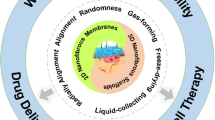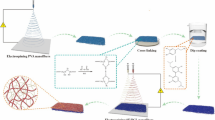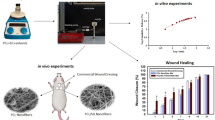Abstract
Excessive exudate at wound sites increases treatment difficulty and severely decelerates the healing process. In wound exudate management, dressings with unidirectional liquid transport capability have exhibited enormous potential. However, it remains challenging to improve the one-way liquid transport efficiency. Herein, a trilayered fibrous dressing is constructed by sequentially electrospinning polyurethane (PU) and polyvinylidene fluoride (PVDF) onto cotton fabric. Through hot pressing, a stable wettability gradient is formed across the PVDF/PU/cotton dressing due to the melting and bridging of PU nanofibers. The trilayered dressing exhibited rapid unidirectional transport with water penetrating from the hydrophobic side to the hydrophilic side in 6 s. The hydrostatic pressure from the hydrophilic side to the hydrophobic side is 569% higher than that from the hydrophobic side to the hydrophilic side, indicating that the dressing has a profound unidirectional conductivity. In vivo experiments demonstrates that the trilayered dressing can accelerate the wound healing process, especially in the early stages of wound occurrence, by quickly draining the excessive exudate. This study provides a new method to construct wound dressings with wettability gradients, which are advantageous for efficient exudate removal.
Graphical Abstract







Similar content being viewed by others
Data availability statement
The datasets generated during and/or analysed during the current study are available from the corresponding author on reasonable request.
References
Xiang SX, Liu DJ, Jiang CC, Zhou WM, Ling D, Zheng WT, Sun XP, Li X, Mao YC, Shan CX. Liquid-Metal-Based dynamic thermoregulating and self-powered electronic skin. Adv Funct Mater 2021;31:2100940.
Metcalfe AD, Ferguson MWJ. Bioengineering skin using mechanisms of regeneration and repair. Biomaterials 2007;28:5100.
Yin J, Xu L, Ahmed A. Batch preparation and characterization of electrospun porous polylactic acid-based nanofiber membranes for antibacterial wound dressing. Adv Fiber Mater 2022;4:832.
Kageyama T, Chun Y-S, Fukuda J. Hair follicle germs containing vascular endothelial cells for hair regenerative medicine. Sci Rep 2021;11:624.
Wang CB, Liang YQ, Huang Y, Li M, Guo BL. Porous photothermal antibacterial antioxidant dual–crosslinked cryogel based on hyaluronic acid/ polydopamine for non-compressible hemostasis and infectious wound repair. J Mater Sci Technol 2022;121:207.
Ma JG, Wu CT. Bioactive inorganic particles-based biomaterials for skin tissue engineering. Exploration 2022;2:20210083.
Sen CK, Gordillo GM, Roy S, Kirsner R, Lambert L, Hunt TK, Gottrup F, Gurtner GC, Longaker MT. Human skin wounds: A major and snowballing threat to public health and the economy. Wound Repair Regen 2009;17:763.
Ruppert DS, Mohammed MM, Ibrahim MM, Bachtiar EO, Erning K, Ansari K, Everitt JI, Brown D, Klitzman B, Koshut W, Gall K, Levinson H. Poly(lactide-co-ε-caprolactone) scaffold promotes equivalent tissue integration and supports skin grafts compared to a predicate collagen scaffold. Wound Repair Regen 2021;29:1035.
Dong YP, Zheng YQ, Zhang KY, Yao YM, Wang LH, Li XR, Yu JY, Ding B. Electrospun nanofibrous materials for wound healing. Adv Fiber Mater 2020;2:212.
Li MR, Hou Q, Zhong LZ, Zhao YL, Fu XB. Macrophage related chronic inflammation in non-healing wounds. Front Immunol 2021;12:2289.
Ovington LG. Dealing with drainage: The what, why, and how of wound exudate. Home Healthc Now 2002;20:368.
Bishop SM, Walker M, Rogers AA, Chen WYJ. Importance of moisture balance at the wound-dressing interface. J Wound Care 2003;12:125.
Singh G, Byrne C, Thomason H, McBain AJ. Investigating the microbial and metalloprotease sequestration properties of superabsorbent wound dressings. Sci Rep 2022;12:4747.
Chen JY, He JH, Yang YT, Qiao LP, Hu J, Zhang J, Guo BL. Antibacterial adhesive self-healing hydrogels to promote diabetic wound healing. Acta Biomater 2022;146:119.
Webb LX, Pape H-C. Current thought regarding the mechanism of action of negative pressure wound therapy with reticulated open cell foam. J Orthop Trauma 2008;22:S135.
Kilgore T, Malia M, Di Giacinto B, Minter S, Samies J. Adjuvant lymphatic osteopathic manipulative treatment in patients with lower-extremity ulcers: Effects on wound healing and edema. J Am Osteopath Assoc 2018;118:798.
Wang J, Lin JW, Chen L, Deng LF, Cui WG. Endogenous electric-field-coupled electrospun short fiber via collecting wound exudation. Adv Mater 2022;34:2108325.
Li Y, Zhang Y, Wang YX, Yu K, Hu EL, Lu F, Shang SM, Xie RQ, Lan GQ. Regulating wound moisture for accelerated healing: A strategy for the continuous drainage of wound exudates by mimicking plant transpiration. Chem Eng J 2022;429:131964.
Sheng LL, Zhang ZWB, Zhang Y, Wang ED, Ma B, Xu Q, Ma LL, Zhang M, Pei G, Chang J. A novel “hot spring”-mimetic hydrogel with excellent angiogenic properties for chronic wound healing. Biomaterials 2021;264:120414.
Sundaramurthi D, Krishnan UM, Sethuraman S. Electrospun nanofibers as scaffolds for skin tissue engineering. Polym Rev 2014;54:348.
Ye S, Jiang L, Wu JM, Su C, Huang CB, Liu XF, Shao W. Flexible amoxicillin-grafted bacterial cellulose sponges for wound dressing: In vitro and in vivo evaluation. ACS Appl Mater Interfaces 2018;10:5862.
Chen SN, Cui SS, Hu JL, Zhou YF, Liu YC. Pectinate nanofiber mat with high absorbency and antibacterial activity: A potential superior wound dressing to alginate and chitosan nanofiber mats. Carbohydr Polym 2017;174:591.
Sasikala ARK, Unnithan AR, Yun Y-H, Park CH, Kim CS. An implantable smart magnetic nanofiber device for endoscopic hyperthermia treatment and tumor-triggered controlled drug release. Acta Biomater 2016;31:122.
Yang XP, Li LF, Yang DZ, Nie J, Ma GP. Electrospun core–shell fibrous 2d scaffold with biocompatible poly(glycerol sebacate) and poly-l-lactic acid for wound healing. Adv Fiber Mater 2020;2:105.
Wan XY, Zhao YC, Li Z, Li LL. Emerging polymeric electrospun fibers: From structural diversity to application in flexible bioelectronics and tissue engineering. Exploration 2022;2:20210029.
Memic A, Abdullah T, Mohammed HS, Joshi Navare K, Colombani T, Bencherif SA. Latest progress in electrospun nanofibers for wound healing applications. ACS Appl Bio Mater 2019;2:952.
Yao XX, Zhu GS, Zhu PG, Ma J, Chen WW, Liu Z, Kong TT. Omniphobic zif-8@hydrogel membrane by microfluidic-emulsion-templating method for wound healing. Adv Funct Mater 2020;30:1909389.
Luo Z, Jiang L, Xu CF, Kai D, Fan XS, You ML, Hui CM, Wu CS, Wu YL, Li ZB. Engineered janus amphipathic polymeric fiber films with unidirectional drainage and anti-adhesion abilities to accelerate wound healing. Chem Eng J 2021;421:127725.
Yang HC, Xie YS, Hou JW, Cheetham AK, Chen V, Darling SB. Janus membranes: Creating asymmetry for energy efficiency. Adv Mater 2018;30:1801495.
Zhang H, Chen CW, Zhang H, Chen GP, Wang YT, Zhao YJ. Janus medical sponge dressings with anisotropic wettability for wound healing. Appl Mater Today 2021;23:101068.
Zhang XM, Lv RJ, Chen LX, Sun RM, Zhang Y, Sheng RT, Du T, Li YH, Qi YF. A multifunctional janus electrospun nanofiber dressing with biofluid draining, monitoring, and antibacterial properties for wound healing. ACS Appl Mater Interfaces 2022;14:12984.
Shi LX, Liu X, Wang WS, Jiang L, Wang ST. A self-pumping dressing for draining excessive biofluid around wounds. Adv Mater 2019;31:1804187.
Zhang KX, Jiao XY, Zhou LP, Wang J, Wang C, Qin Y, Wen YQ. Nanofibrous composite aerogel with multi-bioactive and fluid gating characteristics for promoting diabetic wound healing. Biomaterials 2021;276:121040.
Dai B, Li K, Shi LX, Wan XZ, Liu X, Zhang FL, Jiang L, Wang ST. Bioinspired janus textile with conical micropores for human body moisture and thermal management. Adv Mater 2019;31:1904113.
Xu B, Li A, Wang R, Zhang J, Ding YL, Pan D, Shen ZJ. Elastic janus film for wound dressings: Unidirectional biofluid transport and effectively promoting wound healing. Adv Funct Mater 2021;31:2105265.
Shen Q, Jiang Y, Guo SZ, Huang L, Xie HB, Li L. One-Step electrospinning membranes with gradual-transition wettability gradient for directional fluid transport. J Membr Sci 2022;644:120091.
Dy M, Huang Z, Wang XF, Yu JY, Ding B. Continuous, spontaneous, and directional water transport in the trilayered fibrous membranes for functional moisture wicking textiles. Small 2018;14:1801527.
Li HN, Yang J, Xu ZK. Asymmetric surface engineering for janus membranes. Adv Mater Interfaces 2020;7:1902064.
Huang XW, Wu ZF, Zhang S, Xiao W, Zhang LL, Wang L, Xue HG, Gao JF. Mechanically robust janus nanofibrous membrane with asymmetric wettability for high efficiency emulsion separation. J Hazard Mater 2022;429:128250.
Wang ZX, Yang XB, Cheng ZJ, Liu YY, Shao L, Jiang L. Simply realizing “water diode” janus membranes for multifunctional smart applications. Mater Horiz 2017;4:701.
Wu J, Wang N, Wang L, Dong H, Zhao Y, Jiang L. Unidirectional water-penetration composite fibrous film via electrospinning. Soft Matter 2012;8:5996.
Tian XL, Jin H, Sainio J, Ras RHA, Ikkala O. Droplet and fluid gating by biomimetic janus membranes. Adv Funct Mater 2014;24:6023.
Wang HX, Ding J, Dai LM, Wang XG, Lin T. Directional water-transfer through fabrics induced by asymmetric wettability. J Mater Chem 2010;20:7938.
Mates JE, Schutzius TM, Qin J, Waldroup DE, Megaridis CM. The fluid diode: Tunable unidirectional flow through porous substrates. ACS Appl Mater Interfaces 2014;6:12837.
Guo TQ, Han KY, Heng LP, Cao MY, Jiang L. Ordered porous structure hybrid films generated by breath figures for directional water penetration. RSC Adv 2015;5:88471.
Chen W-Y, Chang H-Y, Lu J-K, Huang Y-C, Harroun SG, Tseng Y-T, Li Y-J, Huang C-C, Chang H-T. Self-Assembly of antimicrobial peptides on gold nanodots: Against multidrug-resistant bacteria and wound-healing application. Adv Funct Mater 2015;25:7189.
Wang L, Yang K, Li XZ, Zhang XH, Zhang DW, Wang LN, Lee CS. A double-crosslinked self-healing antibacterial hydrogel with enhanced mechanical performance for wound treatment. Acta Biomater 2021;124:139.
Qian ST, Wang J, Liu ZM, Mao JY, Zhao BF, Mao XY, Zhang LC, Cheng LY, Zhang YG, Sun XM, Cui WG. Secretory fluid-aggregated janus electrospun short fiber scaffold for wound healing. Small 2022;18:2200799.
Hampton S, Coulborn A, Tadej M, Bree-Aslan C. Using a superabsorbent dressing and antimicrobial for a venous ulcer. British J Nursing 2011;20:S38.
Acknowledgements
This study was supported by a grant from the National Natural Science Foundation of China (51973195), Zhejiang Provincial Key Research and Development Program (2020C03042), and “Ten Thousand Plan”-Zhejiang Provincial High Level Talents Special Support Plan (2020R52023).
Author information
Authors and Affiliations
Corresponding authors
Ethics declarations
Conflict of Interest
There are no conflict of interest to declare.
Additional information
Publisher's Note
Springer Nature remains neutral with regard to jurisdictional claims in published maps and institutional affiliations.
The original version of the article has been revised to add the author photos at the end of the article.
Supplementary Information
Below is the link to the electronic supplementary material.
Supplementary file2 (MP4 464 KB)
Supplementary file3 (MP4 543 KB)
Supplementary file4 (MP4 535 KB)
Supplementary file5 (MP4 559 KB)
Supplementary file6 (MP4 520 KB)
Supplementary file7 (MP4 750 KB)
Rights and permissions
Springer Nature or its licensor (e.g. a society or other partner) holds exclusive rights to this article under a publishing agreement with the author(s) or other rightsholder(s); author self-archiving of the accepted manuscript version of this article is solely governed by the terms of such publishing agreement and applicable law.
About this article
Cite this article
Liu, L., Sun, H., Zhang, J. et al. Trilayered Fibrous Dressing with Wettability Gradient for Spontaneous and Directional Transport of Massive Exudate and Wound Healing Promotion. Adv. Fiber Mater. 5, 574–587 (2023). https://doi.org/10.1007/s42765-022-00239-3
Received:
Accepted:
Published:
Issue Date:
DOI: https://doi.org/10.1007/s42765-022-00239-3




